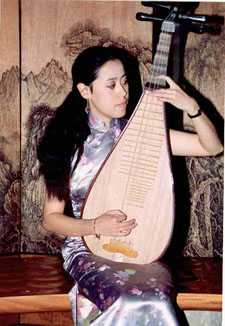Cheng Yu : Pipa
Pipa

The pipa, a fretted lute with four strings, is a close relative of the European lute, the Middle Eastern lutes and the Japanese biwa. It came to China from Central Asia through the "Silk Road" in the 4th-5th century. During the golden age of the Tang Dynasty (618-907 AD), the pipa gained favour over the elegant qin and often served as a lead instrument in the music of the sophisticated Tang court. The pipa has undergone the most dramatic changes of all Chinese instruments today. The upright playing position has gradually replaced the horizontal position of the Tang, plucking with the fingers has replaced the use of a plectrum, the number of frets on the body of the instrument has gradually been increased from 4 to 30, a straight head has replaced the crooked Tang style and the traditional silk strings have been replaced by steel.
The pipa is highly versatile, sharing with the qin an important historical role in the self-cultivation of the elite and the aristocracy of the imperial dynasties, yet it also features prominently in the earthy folk styles of, for example, the Silk-and-Bamboo ensembles of the Shanghai tea houses and the Nanguan narrative singing of Fujian on the southeastern coast. Pipa music is famed for its unique richness of expression.
Four contrasting styles are distinguished in the traditional solo repertoires:
- civil (wen)
- martial (wu)
- suite (da)
- individual (xiao)
Performances will include a selection from the following:
- Ping Sha Luo Yan (Geese Descending on the Sandy Isle)
- Long Chuan (Dragon Boat)
- Deng Yue Jiaohui (Lanterns and Moon Competing in Brilliance)
- Shimian Maifu (Ambushed on Ten Sides)
- Bawang Xie Jia (The Tyrant Removes His Armour)
- Xu Lai (Sounds of Nature)
- Yue'er Gao (The Moon on High)
- Gewu Yin (Song and Dance Prelude)
- Tianshan zhi Chun (Springtime on the Mountains of Tianshan)
- Gao Shan Liu Shui (High Mountains and Flowing Streams)
- Huobajie zhi Ye (Evening of the Torch Festival)
- Yingzhou Gu Diao (Three Ancient Tunes from Yingzhou)
- Yang Chun Bai Xue (White Snow in Sunny Spring)
- Chu Shui Lian (The Awakening Lotus Flower)
- Zhaojun Chu Sai (Zhaojun Leaving for Mongolia)
- Yizu Wuqu (Dance of the Yi People)
- Da Lang Tao Sha (Great Waves Washing Away the Sand)
- Caoyuan Xiao Jiemei (Sisters of the Grassland)
- Song Wo Yizhi Meiguihua (Send Me a Rose)
- Xiyang Xiao Gu (Flute and Drum at Sunset)
